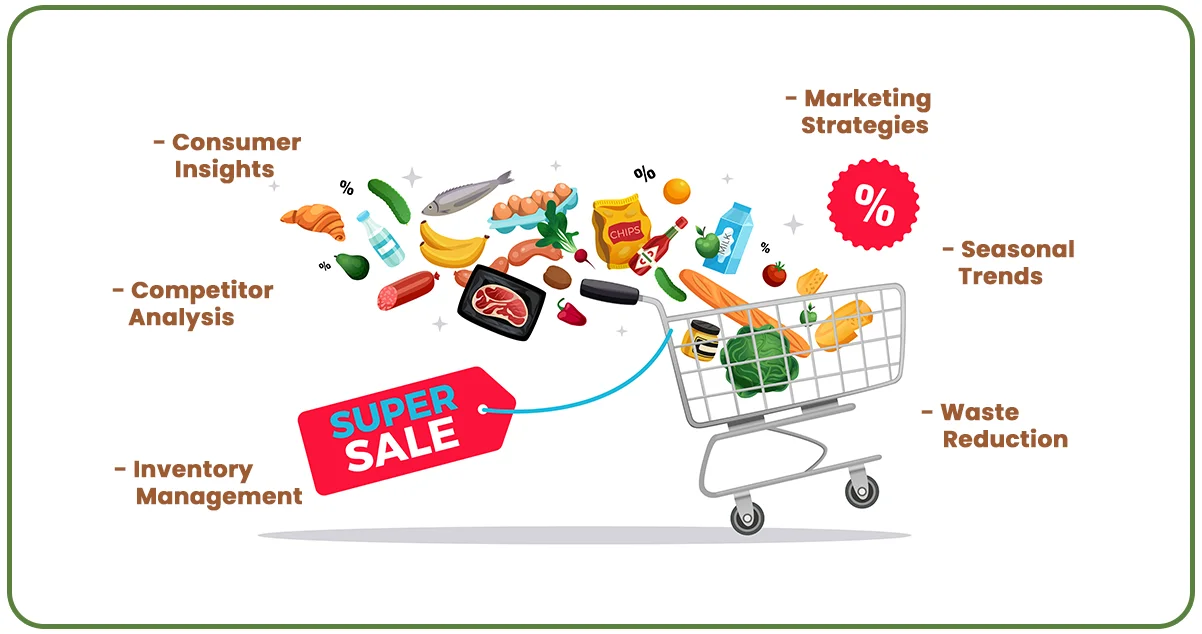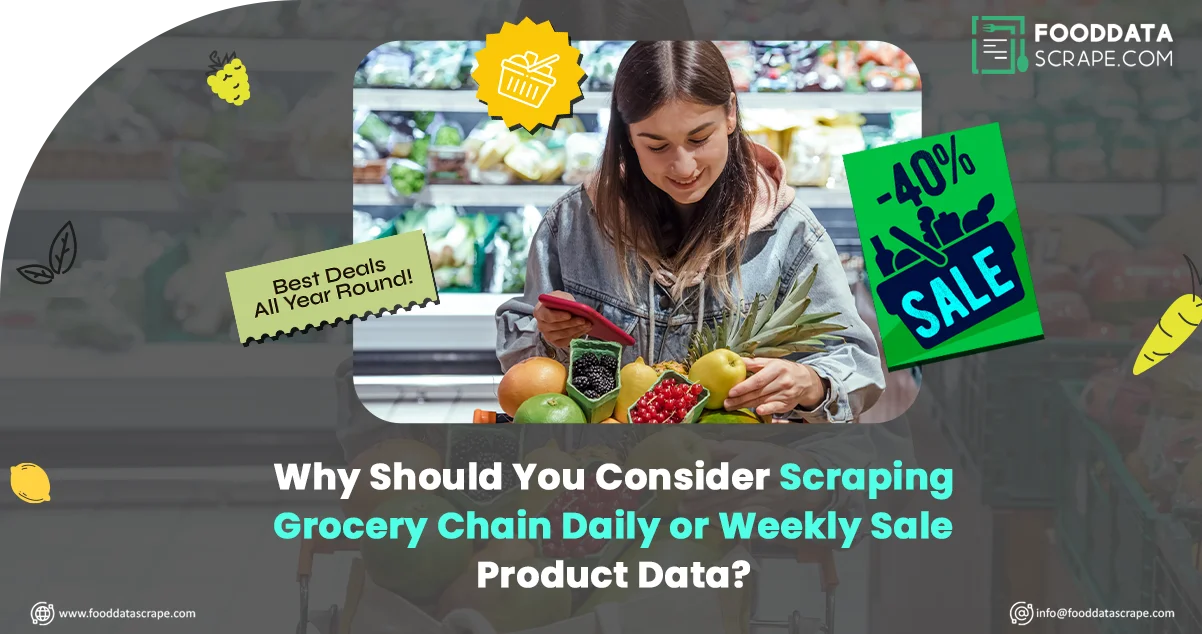In the new world of retailing, especially in grocery retailing, real-time information about products is a game changer. Scraping grocery chain daily or weekly sale product data is very informative about consumption patterns, market movements, and competitors’ planning. This article focuses on how such data is collected and the great value that it affords businesses.
First, it is essential to understand that various businesses can use grocery chain data scraping services to gather valuable data from the internet. They can use tools such as BeautifulSoup or Scrapy to obtain information on product sales, prices, and special offers. This information can also gather details relating to consumer behaviors and the suitable pricing models and stock control strategies that must be implemented.
Scraping data from the grocery chain has several advantages. It enables businesses to make competent decisions, adapt and maintain their market competitive edge by tracking competitors’ strategies, and optimize customer relations by offering appropriate promotions. Data collection on grocery chains helps businesses gain the necessary information to succeed in the contemporary retail industry environment.
Understanding the Importance of Scraping Grocery Chain Sale Data

Scraping grocery chain sale data provides valuable insights into consumer behavior, competitor strategies, and market trends, which are essential for business success.
Consumer Insights: Sale data extraction helps businesses gain valuable information on consumers and their buying behaviors. Businesses can adapt their portfolios by understanding which products will likely sell well among customers. For example, if a specific brand of cereal has a high demand, a grocery chain may decide to allocate more space for the product or run special offers to benefit from its popularity.
Competitor Analysis: Gathering competitor sale data using grocery chain data scraping services helps businesses keep up with market trends. It helps businesses understand the pricing models and products of the competitors and hence work on their own to get the attention of customers. For instance, if the competitor is offering a cut price on the most preferred item, a grocery chain may well decide to offer a better offer just to stop the customers from shifting.
Inventory Management: In managing inventory, real-time data concerning sales must be available at all times. This gives businesses the information to restock products in high demand before stockouts occur. It assists in avoiding stockout situations and guarantees they can get what they want.
Marketing Strategies: Marketing strategies can also be developed from sales data. Promotion is also easier when one knows which products are more popular among customers. For instance, if a given type of fruit, say apples, is doing well in the market, a grocery chain may launch a promotion campaign to boost its sales further.
Seasonal Trends: Secondary sale data can inform analysts about other aspects, such as seasonality. For example, there may be a surge in barbeque accessories sales during the summer and increased soup sales during the cold seasons. Getting updates on these trends makes it easier for business people to adapt to the market in terms of services or products and their marketing strategies.
Waste Reduction: It also enables organizations to know which products have the least sales value in the market and which ones are causing the business to waste resources. Thus, changing the ordering quantities or deleting some products that take a long time to sell is one way to minimize loss and increase profitability.
The Process of Scraping Grocery Chain Sale Data

Scraping grocery chain sale data involves identifying websites, selecting tools, extracting data, and storing it for analysis.
Identify Target Websites: First, decide which grocery chains or retailers’ sale data you are interested in collection. It could encompass large chain stores, corner shops, or websites reputed for providing product descriptions.
Choose a Scraping Tool: Choose a grocery data scraper or framework relevant to your requirements. Options include BeautifulSoup, which is easy to use; Scrapy, which is very powerful; and Selenium, which supports dynamic web pages.
Scraping Script: Write a script to scrape the sale data from the target websites. This may involve assessing the website layout to determine how to move from one page to the other and where to find the information of interest. Your script should be capable of mining data like product name, price, and date of sale.
Navigate Website: You should utilize your script to move through the website’s pages and pull the required data. It can include clicking on links to product pages, reading HTML content, and managing pagination to get all the necessary data.
Extract Data: Once you are on the correct pages, use your scraper to extract the data you want. It is also important to address any potential issues with data formatting, as it may affect data extraction positively or negatively.
Store Data: The extracted data must be stored in a structured format, such as CSV files or databases. It will make it easier to analyze the data and further process as desired.
Analyze Data: After completing the data collection process, you can use the data to learn more about consumers, trends, and competitors. These results help decision-making processes such as price setting, product choices, and promotional campaigns.
Maintain and Update: Remember to check your script and look for additional changes in the website you are collecting from because websites can block scripts. Also, you need to pay attention to the quality of the extracted data to guarantee it is relevant and accurate.
In this way, you can scrape sale data from grocery chains and retailers and use this information to optimize business outcomes.
Benefits of Scraping Grocery Chain Sale Data

Extracting grocery chain sale data gives businesses timely information on decision-making, competition, and consumers.
Data-Driven Decisions: Real-time sale data makes it easy for a business to make decisions because it considers actual events happening in the market rather than hypothetical ones.
Competitive Advantage: Competitor sale data analysis provides business intelligence on pricing and products, enabling companies to better position themselves against rivals.
Improved Customer Engagement: Using sale data to target products and promotions increases consumers’ satisfaction and loyalty, as they are getting information relevant to their patronage.
Inventory Management: Another benefit of providing accurate Grocery datasets is that it enables the management of stock levels to prevent wastage.
Marketing Optimization: Analyzing sales information can optimize marketing efforts. It assists businesses in identifying and reaching their clients with higher returns on investment.
Challenges and Considerations:
Ethical Concerns: It is important to follow certain ethical considerations and legal procedures while navigating websites to prevent legal complications and ensure trust.
Data Quality: When collecting information, it is pivotal to achieve the highest possible data credibility to prevent misinformation.
Conclusion
Therefore, businesses may gather daily or weekly sales product data from grocery chains, which will help them be informed and compete in the market. Consumer behavior, competitor analysis, and managing stock and promotional activities are the main factors the grocery retail industry can use to enhance its growth and performance.
Are you in need of high-class scraping services? Food Data Scrape should be your first point of call. We are undoubtedly the best in Food Data Aggregator and Restaurant Mobile App Scraping, and we render impeccable data analysis for strategic decision-making. With a legacy of excellence as our backbone, we help companies become data-driven, fueling their development. Please take advantage of our tailored solutions that will add value to your business. Contact us today to unlock the value of your data.
























































































